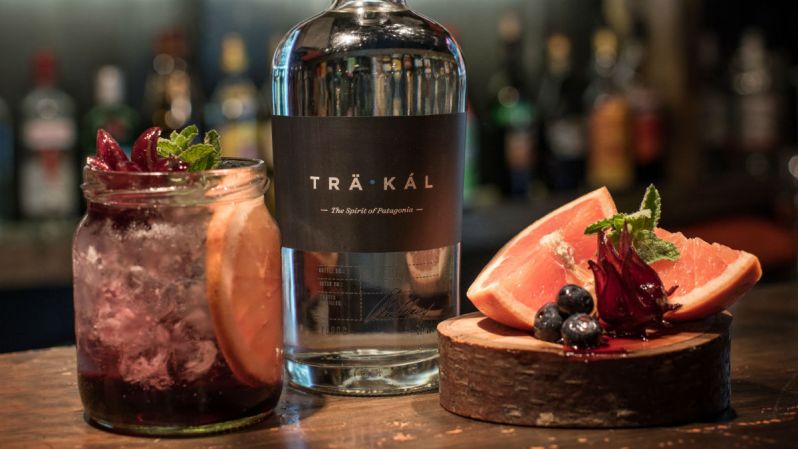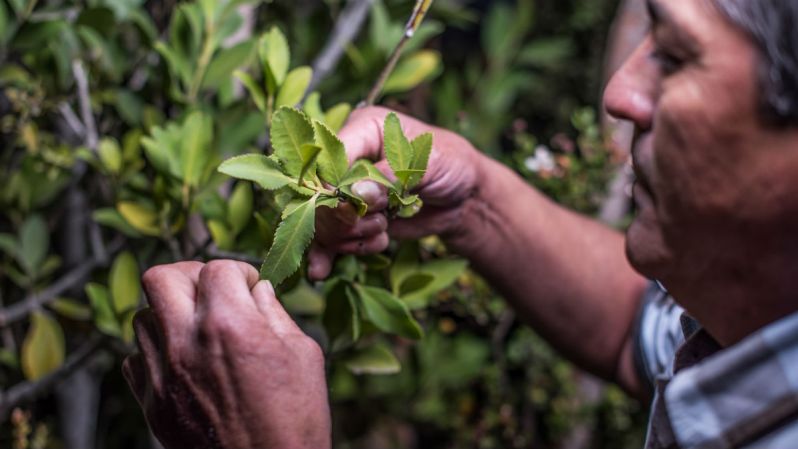When a band of backpackers and fellow ex-pats met by chance in Buenos Aires, Argentina, they decided to go all-in on distilling a new spirit that embodies the rugged beauty of Patagonia. This mountainous region shared by Chile and Argentina would not only be the spiritual inspiration, but the garden for all ingredients used in the making of the booze eventually called Träkál.
“We use local apple and pear varieties to create our base alcohol and work with local communities to hand-pick seven native herbs and four native berries that are all integral to our authentic spirit,” says Träkál co-founder Ben Long.
During the process of finding the perfect balance of ingredients, master distiller Sebastian Gomez Camorino found a way to use Patagonia’s seasonal wild herbs year-round. To capture the flavor profile January through December, Camorino’s mother suggested they make essential oils from each herbal variety. The idea was a success, maintaining the consistency of Träkál’s unique taste and the distillery’s ability to scale production for market. Today, Träkál uses essential oils and vapor infuses fresh herbs on the third and final distillation.
But what exactly does it taste like?

The folks behind Träkál, which clocks in at 42-percent ABV (84 proof), will say that you just have to try it. But it’s recommended both on the rocks and in cocktails.
“The profile is approachable like a gin, but instead of a juniper bite, you get a bit of the sweetness of the apple and pear for a smoother finish,” says Long. “We like to say, it sips like a whiskey and mixes like a gin.”
If that concept is hard to wrap your head around, that’s because Träkál is a completely new spirit classification. The Alcohol and Tobacco Tax and Trade Bureau (TTB) had a similar conundrum, finally deciding to classify the Patagonian creation as a “spirit distilled from apple and pear with natural flavors.”
“Nobody has ever put these herbs and berries into a bottle before, so people can’t quite put their finger on it. They say, ‘OK, this is different,’ and recognized we are a whole new type of spirit,” says Long, adding that the struggle to classify Träkál was a bit of a roadblock in getting the liquor distributed. “We went back to the Chilean authorities and they also had no idea how to classify our spirit, which took time. But the brand is also the category.”
Just like Chartreuse is Chartreuse, they say Träkál is Träkál, and hope that once the brand expands (they’re currently only available in Chile and Colorado, but you can get a bottle shipped to you by The Proper Pour of Denver), people will correlate Patagonia to Träkál the way Scotland is to whisky and Mexico to mezcal.

The co-founders of Träkál are serious about maintaining the integrity of their brainchild, so much that the bottle itself is Chilean-sourced with a natural cork. The distillery is also located in Patagonia, and the spirit is made in batches using water sourced from an underground river.
And, yes, Long does admit it would have been easier had they decided to make another vodka or gin, but as recovering backpackers, there would have been no adventure in that. “We want to show the world that Patagonia can be a distilling destination and honor its botanicals and be authentic to that,” Long adds. “Our friends said, ‘Oh, you should have just done a gin, to be more marketable,’ but juniper doesn’t grow in Patagonia.”
We’re grateful because, to be honest, the world doesn’t need another vodka or gin. What we need is a spirit for Patagonia that embodies the luscious yet rugged terrain, complete with deserts, pampas, and grasslands. Träkál has forged this new path, which helps explain the name that translates to “the first warrior in battle.”
For more information on Träkál’s availability, sign up for alerts here.
Images courtesy of Träkál.


